7 challenges in new product development and best practices to address them

In today’s dynamic business environment, new product development and innovation are crucial for companies to remain competitive and continue to meet changing consumer demands.
However, there are many challenges that companies face when embarking on initiatives of this caliber. Challenges that, in many cases, can prevent a product from reaching the market in a timely manner, or, if it does, from doing so successfully.
In this article, we will analyze the most common challenges faced by companies when managing new product development projects. In addition, we will propose a series of strategies and best practices to overcome these obstacles successfully.
A brief overview of the New Product Development landscape
New Product Development can be defined as the process of creating a product that has never been commercialized, from the conception of an idea to its market launch.

NEW PRODUCT DEVELOPMENT
Build better products, faster
See how Triskell Software can help you to manage every aspect of New Product Development.
It consists of 7 distinct phases:
- Market research: it all starts with an in-depth study of consumer needs and desires, as well as analyzing the competition.
- Idea generation and evaluation: next, product concepts that can satisfy these needs are created for subsequent evaluation.
- Concept development: once the idea is approved, the product’s features, benefits and attributes are further defined.
- Design and prototyping: an attractive and functional product design is created,
- Development: this is the process by which the initial design and prototype becomes a real product.
- Testing: the product is tested to ensure that it meets pre-established quality and safety standards.
- Market launch: the product is introduced to the market through marketing and sales strategies.
It is an iterative and dynamic process, which implies that adjustments may arise at any stage according to the results of the final product testing, feedback received or changing market conditions.
This dynamism that defines New Product Development projects is the main headache of all companies. And we don’t say so, the statistics say so: Most new products fail in their first year. This fact highlights the importance of understanding and addressing the challenges of New Product Development throughout all phases of the process.
SUBSCRIBE TO OUR NEWSLETTER
Get stories like this in your inbox
New Product Development challenge #1: Idea validation and prioritization
One of the most critical challenges in new product development is to identify which ideas have the greatest potential for market success and prioritize them based on their feasibility and alignment with strategic objectives.
These ideas can come from a variety of sources: employees, executives, shareholders, market research, and even competitors. However, not all ideas can go forward, so the challenge is to establish a rigorous and efficient idea validation workflow.
This idea validation must cover different aspects, such as the technical feasibility of the idea, the potential market demand or its financial impact. If this assessment process is not well executed, it is very likely that the product to be developed will not meet market expectations, which will imply a significant waste of time and resources.
Best practices to overcome this challenge
Therefore, to ensure that this flow of validation and prioritization of ideas is efficient, we recommend you follow some of these best practices:
- Establish clear prioritization criteria: define key indicators such as technical feasibility, market attractiveness or strategic alignment. In addition, make sure that all stakeholders involved in the validation process understand these criteria.
- Involve more teams in the decision-making process: when asking for feedback, do not only ask for it from the product and development teams, but involve other areas of the company in the process. Marketing, Sales, IT, Finance… The opinion of all these departments will help the evaluation process to be more comprehensive.
- Conduct regular reviews: you should establish monthly or quarterly checkpoints to review ideas and reprioritize them according to changes in market or company circumstances.
- Implement an ideas removal process: you can reduce the backlog of ideas through a multi-stage voting system, where the lowest scoring ideas are eliminated at each stage. Or you can also discard ideas that are more than 6 months or a year old, for example.
Pro tip:
Triskell’s PPM platform can be your centralized repository of ideas from which you can quantitatively evaluate each idea based on the prioritization criteria you have established. You can use its Scenario Simulation feature to predict how these ideas will affect resource allocation and project development times.
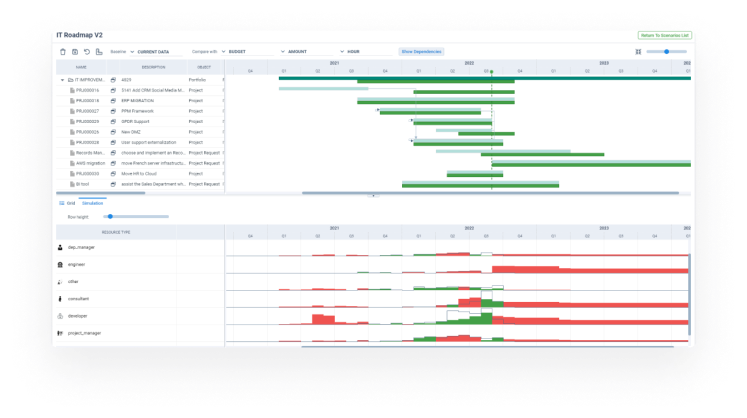
New Product Development challenge #2: Resource constraints
In today’s business environment, where demand for new products is ever-increasing, resource constraints are a constant concern. Companies have real headaches when it comes to properly allocating resources across multiple projects, which can delay the launch of critical products or generate unforeseen cost overruns.
Add to this the day-to-day reality of development teams. Their daily responsibilities are not only focused on product development, but they must also perform other tasks, such as implementing process improvements or performing maintenance tasks on existing products.
In addition, the lack of staff with a qualified technical background further complicates the issue, which can compromise the quality of the final products.
Ready to improve your product development workflow?
Discover how Triskell can help you manage resource constraints, market shifts, and stakeholder communication. Request a demo today to see it in action!
Best practices to overcome this challenge
- Prioritize projects based on their strategic impact: not all projects have the same strategic importance. Therefore, we insist again on the importance of defining a prioritization system, in which the most profitable or strategic New Product Development and R&D projects receive most of the resources.
- Automate processes: identify time-consuming activities or manual administrative tasks that can be automated to free up time and increase the productivity of your teams.
- Establish clear resource boundaries from the start: be transparent with product teams and make it clear from the beginning what resources they will have.
- Train your teams: invest in training employees so you can reduce the need to hire more staff.
Pro tip:
Triskell’s Resource Management capabilities provide a comprehensive, real-time view of your organization’s capacity. You will be able to allocate resources in an agile and dynamic way according to the strategic priorities of each project, thus reducing bottlenecks and the workload of your teams.
New Product Development challenge #3: Changing consumer and market demands
Another challenge in new product development is how quickly market demands and consumer preferences change. An idea that may seem like an opportunity today can become obsolete in just a few weeks or months. Therefore, companies that fail to react quickly run the risk of launching products that are not in demand, resulting in significant losses for the company.
In addition, consumers are becoming increasingly demanding and have a wide range of products at their fingertips. This makes it even more difficult to accurately anticipate which functionalities or solutions will have the best market outlets.
Best practices to overcome this challenge
- Continuously monitor market trends: you can use data analytics tools or market reports to keep abreast of changes in consumer demands.
- Be Agile: whenever the nature of the activities allows it, implement Agile methodologies, such as Scrum or Kanban, so that teams can react quickly to changing priorities or customer demands.
- Perform proof-of-concepts: develop quick prototypes that can be validated by customers before committing fully to a new product or feature.
- Create an innovation committee: assemble a cross-functional team to evaluate new trends and analyze potential changes to your product portfolio roadmaps.
Pro tip:
With Triskell, you can quickly adjust the strategic planning and priorities of your project and product portfolios at any time. It also allows you to communicate in real time those changes to the teams, thus ensuring that everyone is aligned with the new business objectives.
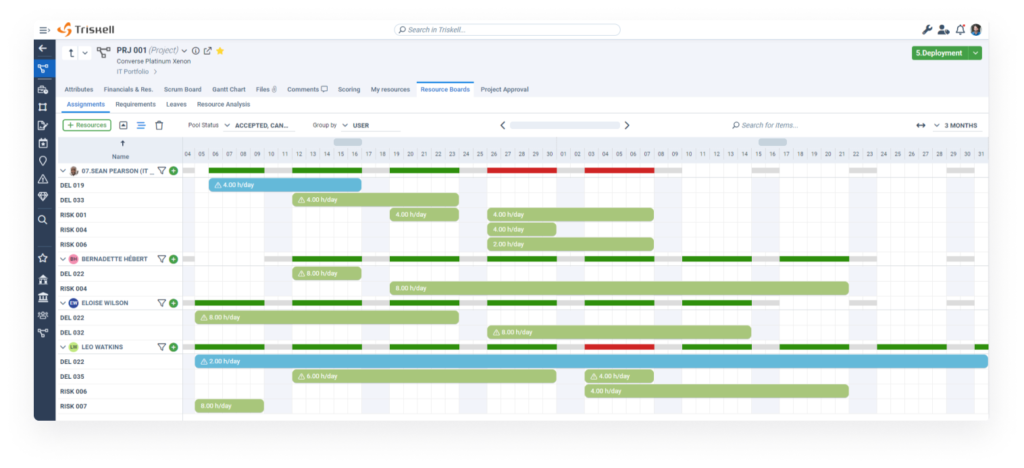
New Product Development challenge #4: Budget management
New product development is a capital-intensive process. From research and design costs to prototyping, testing, manufacturing and marketing expenses, the total expenditure increases very rapidly in these types of initiatives. Therefore, inefficient budget management can result in cost overruns or products that do not generate the expected return on investment.
This is a very complex challenge, even more so because of the number of variables that organizations have to keep track of:
- CAPEX and OPEX.
- Personnel and facilities costs.
- Possible variations in the market.
- Fluctuations in material prices.
- Changes in regulations that can also influence costs.
- Etc.
Best practices to overcome this challenge
- Break down the budget into key categories: track both operating expenses (OPEX) and capital expenditures (CAPEX) to gain control of costs in each area.
- Use real-time financial tracking tools: implement solutions to track project financial management to see costs at each stage of the project and correct deviations immediately.
- Plan with a contingency fund: set aside a percentage of the total budget (between 10 and 15%) to deal with unforeseen events that may arise during the development of each project.
- Review the budget periodically: make monthly or quarterly reviews of the costs against the budget so that the project remains within the margins.
Pro tip:
With Triskell’s financial management capabilities, you can track all project expenses in real time. It allows you to break down costs into different categories (CAPEX, OPEX, etc.), and provides real-time financial reports that allow you to identify variances and adjust the budget as needed. In addition, you will be able to simulate financial scenarios and foresee possible cost overruns.
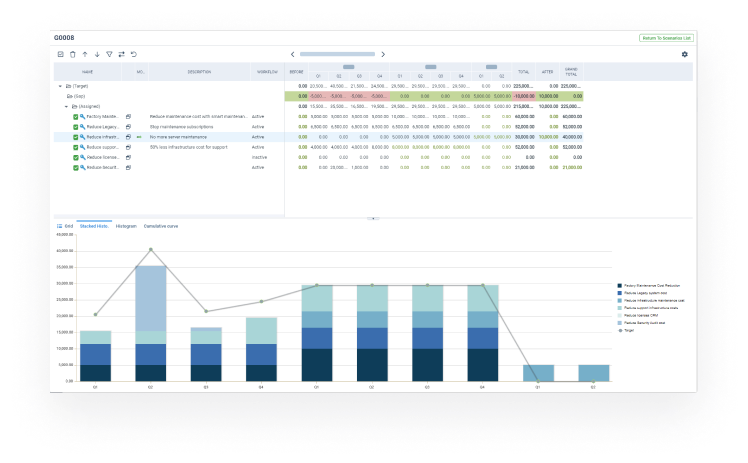
New Product Development challenge #5: Quality control
The next issue we are going to unpack is quality control. One of the major challenges in new product development is that many organizations do not implement a structured approach to ensure that each phase of the project maintains appropriate quality levels. And, without this framework to ensure that quality standards are met, products may not meet market expectations.
This is where Phase-Gate comes in to play a key role in successfully addressing this challenge. This model divides new product development into phases with ‘gates’ at the end of each phase that serve as quality control. Here, it is analyzed that the quality criteria established for that phase have been met and that there are no major risks that could compromise the success of the project in the next stages.
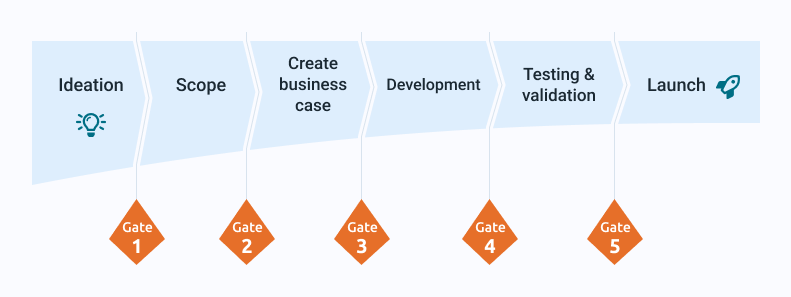
Best practices to overcome this challenge
- Establish clearly differentiated phases: split each project into specific phases. And, for each phase, establish a clear set of defined objectives and deliverables. For example, for the design phase, ensure that the prototype meets the technical and functional requirements you have established before moving on to the development phase.
- Define clear criteria at each control Gate: you must precisely define the quality criteria that must be met at the end of each phase before giving the go-ahead to proceed. These criteria will vary from phase to phase, and include aspects such as product functionality, performance testing, security, regulatory compliance, etc.
- Document findings and corrective actions: After each review, document any relevant findings and corrective actions to be taken. If something does not meet quality standards, implement improvements before moving to the next phase.
- Adjust deadlines based on quality: Tight deadlines can often be the great enemy of quality control. Phase-Gate can serve you as a safeguard so that project progress between phases is conditioned primarily by exceeding quality criteria, not just a question of time.
Pro tip:
With Triskell’s financial management capabilities, you can track all project expenses in real time. It allows you to break down costs into different categories (CAPEX, OPEX, etc.), and provides real-time financial reports that allow you to identify variances and adjust the budget as needed. In addition, you will be able to simulate financial scenarios and foresee possible cost overruns.
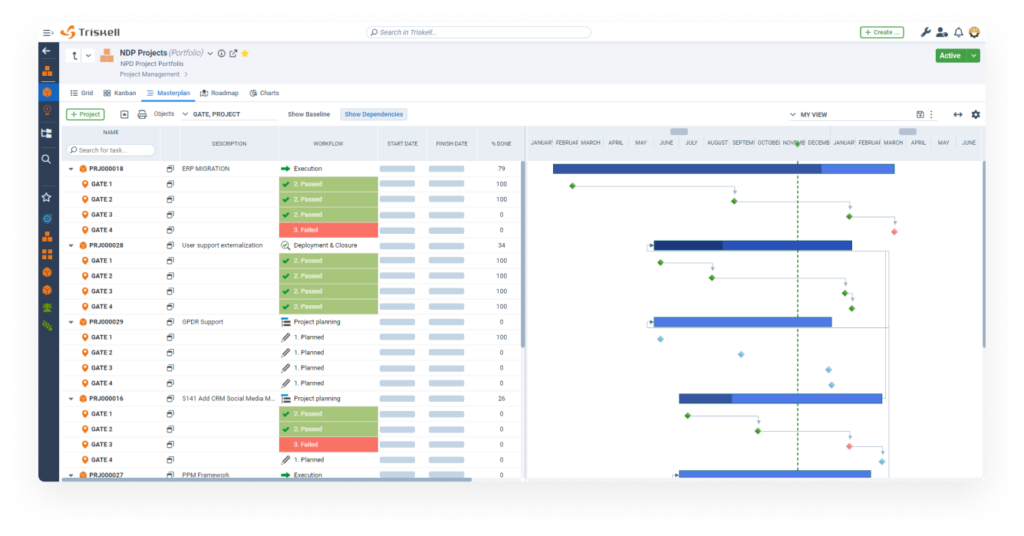
New Product Development challenge #6: Project prioritization and execution issues
Resource and time constraints are the bread and butter of new product development projects. It is very common for tasks to exceed the availability of resources, which ends up generating delays, bottlenecks and, worst of all, a negative impact on the final quality of the product.
If we add to these other common problems, such as scope changes, cost overruns or changes in project portfolio priorities, product development can be a real headache.
In this context, Product Managers and team leaders are required to manage multiple demands, meet deadlines, allocate resources efficiently, and ensure that product quality is not compromised. In addition, the market continues to evolve and demands new product launches, adding even more pressure to the need to develop products faster without overwhelming the organization’s capacity.
PROJECT PORTFOLIO MANAGEMENT
Drive strategic project success
See how Triskell’s PPM Software can help you to maximize efficiency and prioritize your most important projects.
Best practices to overcome this challenge
- Realistic and continuous capacity planning: conduct quarterly reviews of your organization’s capacity, comparing planned tasks with actual hours worked. With this information, you will be able to adjust deadlines and reassign tasks if necessary, avoiding bottlenecks in critical projects.
- Dynamic prioritization of product portfolios: in case you have capacity issues, you should use an adaptive or agile prioritization approach. That is, evaluate which projects provide the greatest strategic value in the short-medium term and adjust the allocation of resources based on this analysis.
- Simulate different scenarios: before adjusting deadlines or increasing the workload of your teams, simulate different scenarios to see which option will have the least negative impact. You will then be able to manage the resources and deadlines of your product portfolios with greater precision and less risk.
- Proactively manage scope changes: scope changes often generate many conflicts, both in capacity planning and in the day-to-day with stakeholders. Therefore, it is advisable to establish a system whereby any scope changes go through a formal review and be sure to clearly communicate to stakeholders the impact these changes will have on timelines and resource allocation.
Pro tip:
With Triskell, you’ll be able to track resource availability in real time and thus identify if incoming demand exceeds your organization’s capacity.
In addition, with its Scenario Simulation functionality, you will be able to make estimates of many different kinds. For example, you can evaluate how a delay in one of your initiatives will affect the rest of your product portfolios. Or how reassigning personnel to another task can improve results.
New Product Development challenge #7: Stakeholder communication
And the last challenge in New Product Development that we are going to address in this article is communication with the different stakeholders. A key aspect that is often neglected by product teams and managers.
Meeting the expectations of all stakeholders when developing a new product is something really complex. Throughout the development process, conflicts will arise between the various stakeholder groups that can only be resolved with an appropriate communication strategy.
Best practices to overcome this challenge
- Establish a clear communication strategy: make sure that all stakeholders know how and when they will be informed about project progress. Developing a RACI matrix will help you in this regard.
- Use online collaboration tools: use applications such as Teams, Slack, Notion or a PPM tool to enable teams to collaborate with each other and facilitate communication with different stakeholders.
- Maintain continuous feedback loops: make sure that stakeholders can give feedback at all times and that they receive a quick response.
- Document all agreements and changes: audit all agreed decisions and changes to avoid confusion and misunderstandings in the future.
Pro tip:
With Triskell, you can centralize all data related to your project and product portfolios in a single platform, so executives and other stakeholders can consult them at any time. In addition, with Triskell you can:
- Customize reports and dashboards according to stakeholder types, offering each group the most relevant data for them (KPIs and financial metrics, critical deadlines, etc.).
- Set up alerts and notifications when there are important changes in the progress of tasks.
- Facilitate continuous feedback with clients and stakeholders with the collaboration and communication features.
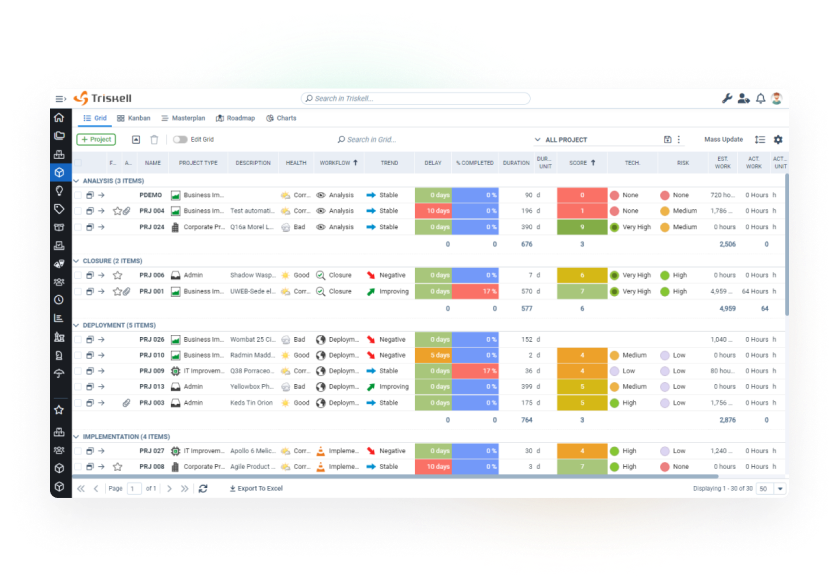
Conclusion: Triskell, your partner to address all New Product Development challenges
As you can see, new product development is a complex process full of challenges from even idea generation and validation. However, with the right strategies and the right tools, these challenges can be successfully addressed.
Triskell Software offers a comprehensive platform that helps companies manage every aspect of new product development, ensuring that projects are executed efficiently, on budget and on time.
With Triskell, your company can not only overcome the hurdles of new product development, but also improve its ability to innovate and stay competitive in the marketplace.
Request a demo of Triskell Software
Want to know how Triskell Software can help you to manage your organization’s R&D projects? Check it out for yourself and request a Triskell demo now.
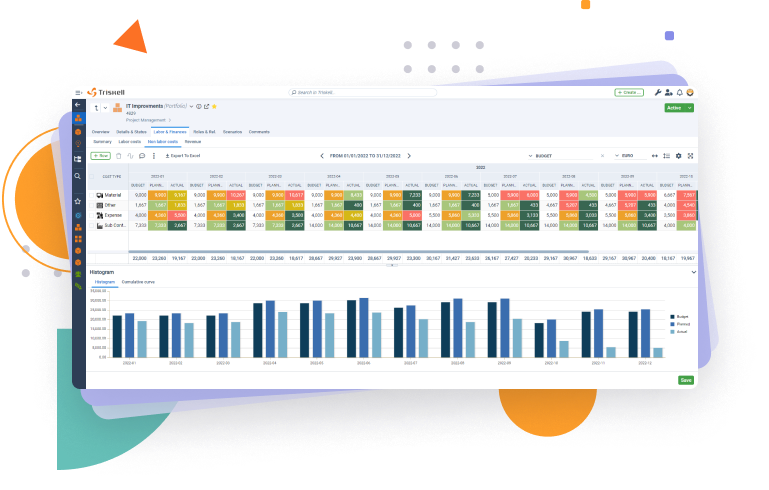
Related Content

10 types of Project Management Offices (PMO): structure, purpose and how to choose the right one
Learn about different PMO types, their governance levels, and which one is the best fit for your company’s project management needs.

How to create a project budget: methods and techniques for effective project budgeting
Learn how to create a project budget with this detailed guide. Discover essential methods and techniques for effective project budgeting in PPM.

20 strategic planning models and tools for medium and large companies
Looking for the best strategic planning frameworks? This guide covers 20 proven models to enhance decision-making and business growth.
FAQs about New Product Development best practices
How can you ensure that prioritization of ideas is not influenced by subjective decisions?
A structured approach based on objective criteria is essential to prevent decisions on which ideas to prioritize from being influenced by personal or subjective preferences. Implementing a methodology such as weighted scoring is an effective solution.
Triskell allows you to define quantitative criteria (technical feasibility, financial impact, strategic alignment, etc.) and assign a weight to them. This provides a more objective assessment, which helps to make decisions aligned with the company’s objectives.
What additional strategies can I use when resources are extremely limited?
When resources are extremely scarce, in addition to prioritizing projects, it is useful to explore collaborations with external teams or strategic partners, outsourcing certain non-critical tasks or seeking support in highly specialized areas. Another option is to invest in automation tools to maximize efficiency.
With Triskell, you can quickly identify bottlenecks and look for alternatives such as role restructuring or redistribution of responsibilities to optimize the use of available resources.
What should I do if quality issues arise late in the project?
When quality problems arise late in the project, it is essential to perform a quick assessment to determine if it is a localized problem or if there is a systemic failure throughout the process. If possible, go back to the phase where the problem arose and adjust procedures to correct it. Also, seek to learn from mistakes to avoid repeating them in future projects.
With Triskell, you can review the history of each project phase, analyze past quality control points and make adjustments in real time.

